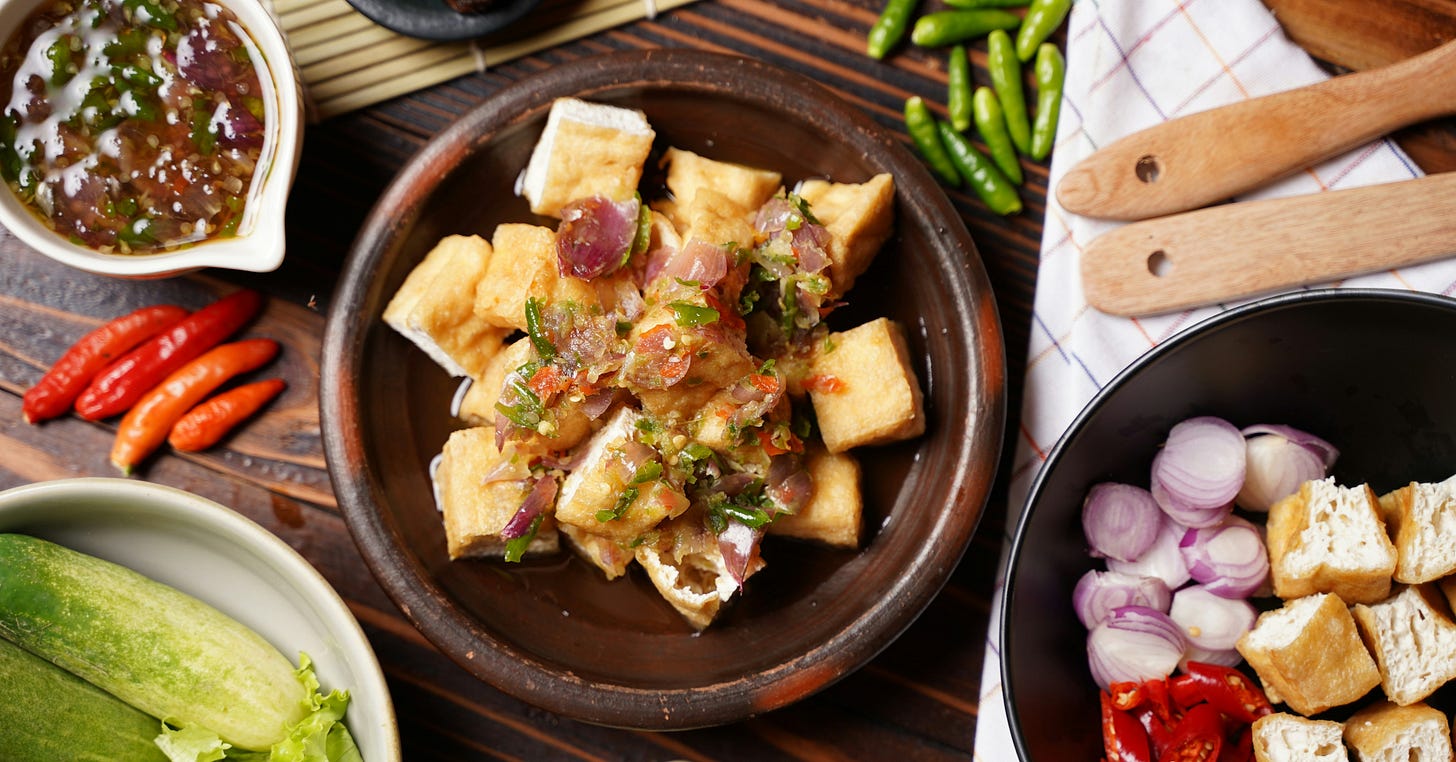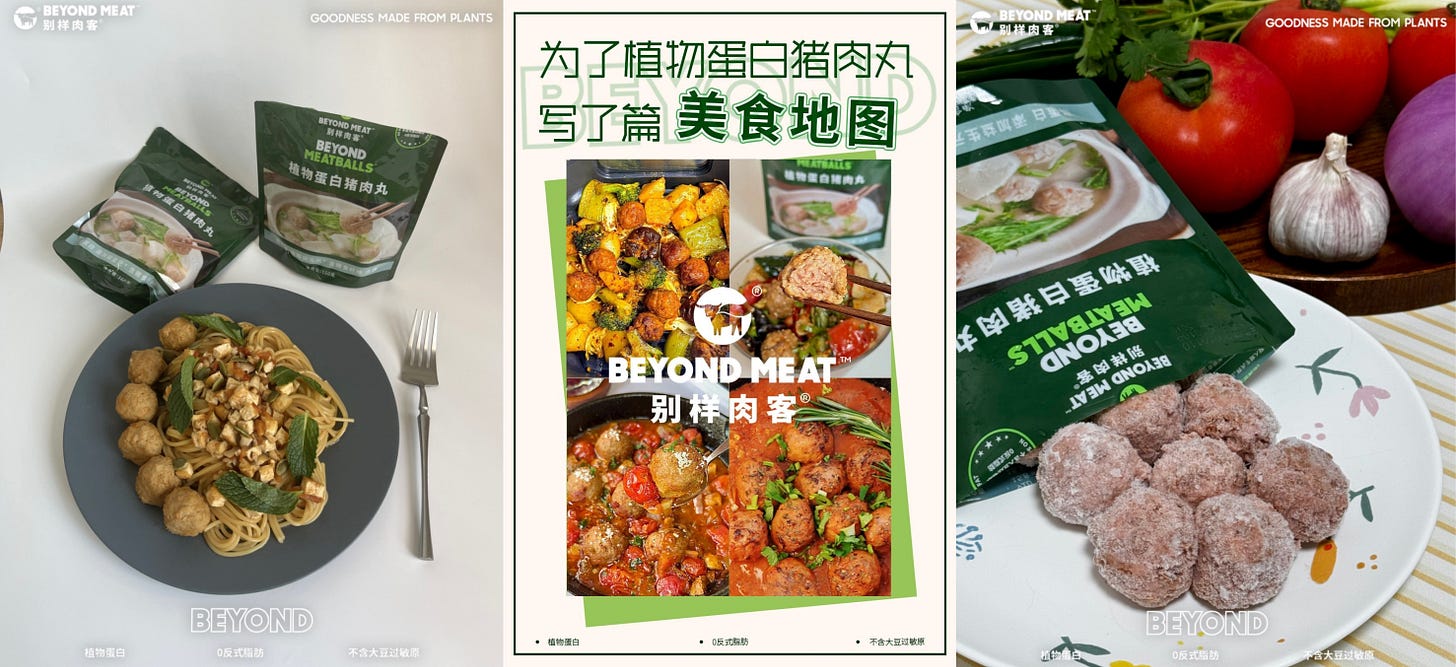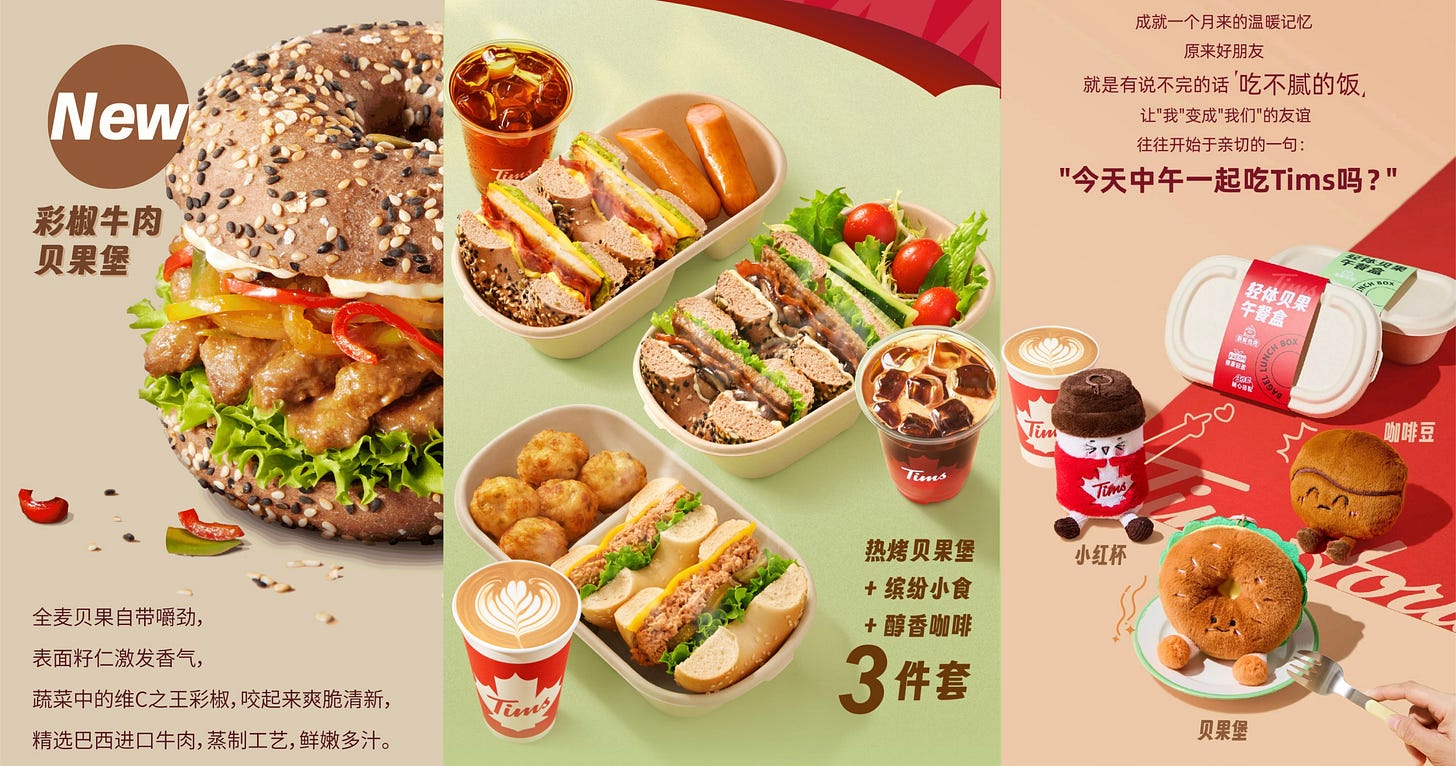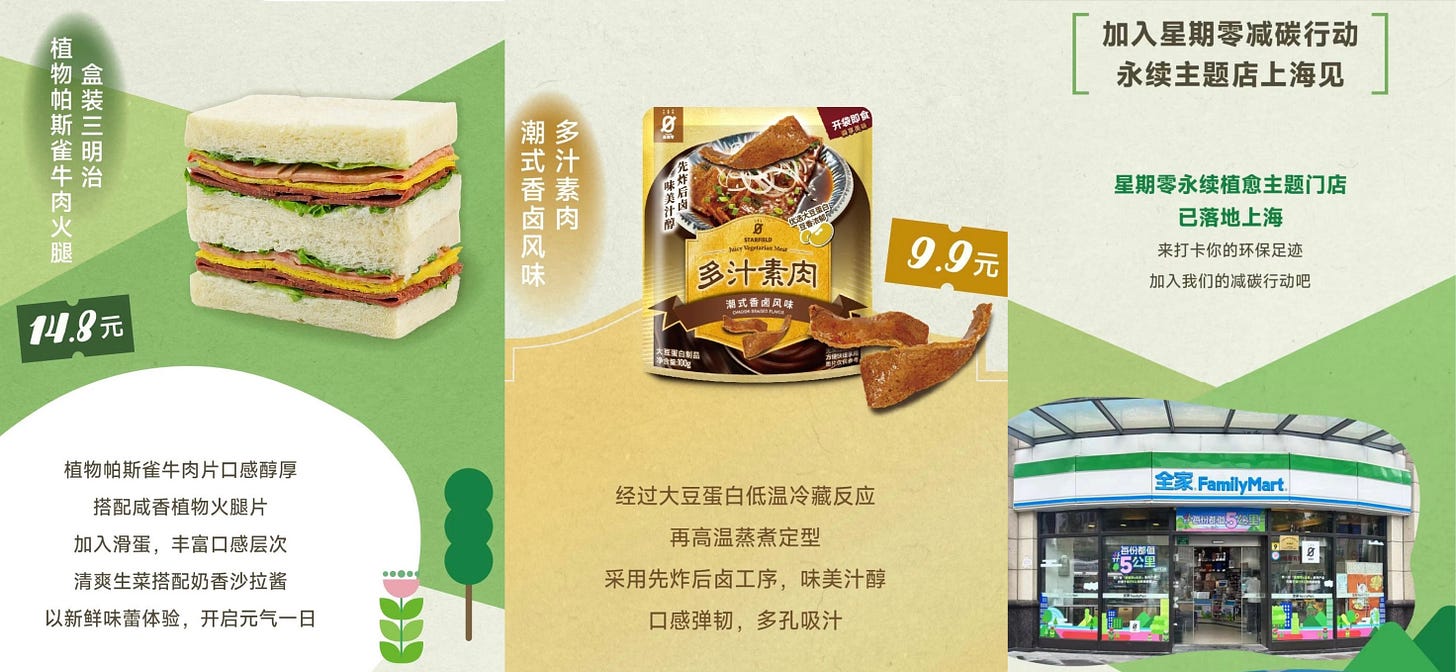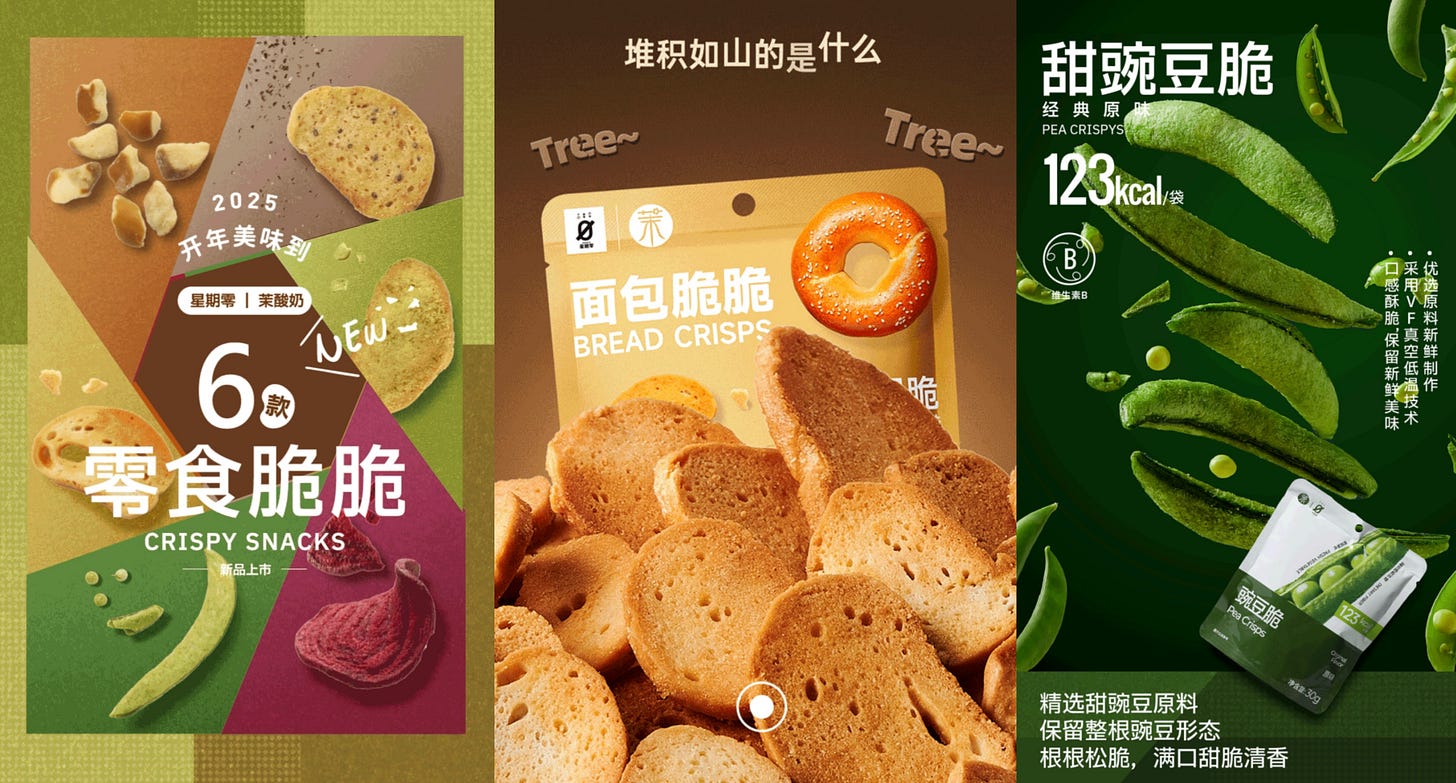Dao Foods views China as the world's most important protein and food market from both a climate impact and business opportunity perspective. Our new series China Food for Thought delves into the rapidly evolving alternative protein sector in China, and the broader market trends within the food industry. We selectively curate and share industry news from China with international audiences that may lack easy access to news and trends in China. Our goal is to provide readers with a ground-up view of valuable industry content from the Dao Foods perspective.
1. Beyond Meat Retreats from China — Is the Market to Blame?
On April 8, 2025, Beyond Meatʼs stock hit an all-time low of US $2.67—a stark contrast to its peak of US $239 in 2019. The companyʼs latest earnings report revealed 2024 net revenues of US $343.4 million, down 18% year-over-year, alongside a gross profit loss of US $82.7 million—a decline from its US $23.7 million loss the previous year.
In response, the company is undergoing layoffs and restructuring. It plans to cut 44 jobs across North America and the EU, alongside implementing unspecified “executive leadership changes.” Beyond Meat, which has reported declining sales for four consecutive years, is also preparing to suspend its China operations as part of a broader cost-cutting initiative. The suspension, scheduled for the end of June 2025, will result in the elimination of an additional 20 positions—representing 95% of its workforce in China.
The company stated it expects to incur one-time, non-cash charges of US $12 million to US $17 million, primarily related to accelerated depreciation, impairment charges, and other asset write-downs associated with its China operations. Beyond Meat had previously invested over US $40 million into its Chinese subsidiary.
Please note that we have no intention of commenting on Beyond Meat’s China strategy in any structured way via this article but would like to focus on examining a few criticisms of Beyond Meat in North America in a China context.
According to several articles[1], the main criticisms against Beyond Meat in North America include:
Ultra-Processed Food Concerns - Is Beyond Meat an ultra-processed food? Is it really healthy?
The Price Is High - Is it too expensive—more costly than real meat?
The Taste Doesnʼt Match Real Meat - Does it taste as good as real meat?
The company largely applied the same strategies used in North America, failing to recognize that these core criticisms would resonate differently in a vastly different market. Letʼs examine how each of these challenges unfolded in China.
Importantly, the challenges Beyond Meat faces are not unique. They reflect broader barriers that many plant-based brands—both in China and globally—encounter when trying to scale with mainstream consumers. This analysis is not about singling out Beyond Meat, but rather about identifying the changes needed for plant-based companies to succeed in the markets.
Ultra-Processed Food Concerns
Since its inception, Beyond Meat has faced criticism suggesting its products are ultra-processed. This criticism began in earnest around 2020 and has intensified in recent years. In an interview at the end of 2024, Ethan Brown admitted that Beyond Meat has been deeply affected by these negative ads. He added that he prefers not to engage in this conflict, saying, “If you wrestle with a pig, you get a lot of mud.ˮ
If you browse social media posts about plant-based meat in China, you ʼll find Chinese consumers echoing similar concerns:
“If I want to eat less meat to be healthier, I’d eat more vegetables and soy products — so why would I choose processed plant-based meat?ˮ
“Exactly, I saw the same thing in U.S. media, they said plant-based meat is not healthy.ˮ
“Americans donʼt even eat this unhealthy food—they just sell it to China.ˮ
Given that Beyond Meat didnʼt respond to these claims in the U.S., itʼs no surprise that its China division also didnʼt adopt any significant communication strategies to counter them.
Instead of fighting back, Brown chose to “get stronger ˮ by improving the formula. But isnʼt one of the most important rules of public relations to respond quickly and address the issue head-on? If you miss the right timing, the negative impression becomes fixed in consumersʼ minds — Chinese consumers are not an exception.
The Price Is High
Though Brown has stated that the goal is to achieve price parity with animal meat, Beyond Meatʼs products remain more expensive. In the U.S., ground beef averages US $5.60 per pound, while Beyond Meat is US $7.99 per pound. The price gap is even more pronounced in China: regular beef is ¥6 per 100g, whereas Beyond Meat costs at least ¥10 per 100g (when itʼs on sale).
Chinese traditional faux meat brands offer ground beef that costs over 50% less than Beyond Meat, at ¥5 per 100g. Besides, Chinese consumers enjoy a diverse range of plant-based proteins—such as tofu (¥0.7 per 100g) and wheat gluten (¥2 per 100g)—priced at just one-tenth of Beyond Meat product cost.
Beyond Meat also doesn't appear to be moving toward lower prices at least in the US market. In 2024, the company raised the suggested retail price of an 8-ounce pack of two burger patties by US $1 to $6.99. This price hike was partly to offset rising ingredient costs and partly to improve margins. Brown has argued that health-conscious and environmentally-minded consumers are generally “price-insensitive.ˮ
That might be true to an extent, but relying solely on a niche segment, especially amid rising inflation, is risky. Even environmentally conscious shoppers are becoming more price-sensitive. Itʼs difficult to compete in the broader market when your core audience is so limited.
The Taste Doesn’t Match Real Meat
“The plant-based meat industry is still struggling to figure out how best to appeal to customers, many of whom are more concerned with price, taste, and texture than with the environmental or health benefits of meat alternatives,ˮ said Rachel Wolff, an analyst with eMarketer.
Early on, Beyond Meat and others leveraged the novelty of plant-based meat and the rise of flexitarianism. Consumers may try the products once out of curiosity or for health/environmental reasons, but repeat purchases depend on whether the product satisfies taste expectations. Judging by the declining sales, plant-based producers have yet to win over the mainstream consumers. Only the most committed vegans and vegetarians are willing to continually sacrifice taste and texture, as it seems.
Dao Foodsʼ co-founder Tao Zhang said in his TED talk in 2023:
“To be successful and have an impact, entrepreneurs canʼt just come out with a product that neatly swaps for meat. Alternatives must be tasty, affordable, and regionally appropriate. This calls for investments in innovation, research, and development.ˮ
As a learning exercise, letʼs next examine Beyond Meatʼs approach to the Chinese market to see if there are any things that entrepreneurs, either international or Chinese, can learn.
1. Target Customers and Localized Products
Beyond Meat’s strategy in China has been unclear from the start. The company could have focused on younger, mainstream consumers who are open to trying new things, but this would have required products that were visually appealing, delicious, and fun. If that was the goal, the execution obviously fell short.
In February 2025,Beyond Meat launched pork-flavored plant-based meatballs tailored to Chinese tastes. However, the product was priced at ¥40 for 160 grams — more than ten times the price of traditional pork meatballs, which are widely available at ¥11.8 per 500 grams. The launch relied solely on low-key posts on local social media outlets WeChat and Rednote, accompanied by lackluster photos and minimal marketing support. The combination of a steep price gap and uninspired promotion made it difficult to attract the Gen Z consumers Beyond Meat seemed to be targeting.
Tim Hortons, which entered China the same year as Beyond Meat in 2019, initially positioned itself with its signature coffee and donut combination. However, the Chinese team quickly pivoted after internal data revealed unexpectedly strong demand for bagels — and noted that Chinese consumers are generally less fond of sweet treats. Bagels, lower in oil and calories than typical baked goods, resonated with health-conscious Chinese consumers.
Tim Hortons capitalized on this insight. The company elevated bagels from a secondary item to a core offering, while localizing flavors and emphasizing hot, savory menu options — preferences deeply rooted in Chinese food culture. The strategy proved effective: more than 58 million bagels have been sold since the brand’s entry, and today, hot food accounts for more than half of its orders in China. This has also helped differentiate Tim Hortons from other coffee chains, which tend to focus primarily on beverages and offer only limited hot food options.
The brand has consistently localized, from product development to marketing. On Valentine’s Day 2025, its tomato-flavored coffee went viral, capitalizing on the broader trend of tomato-based dishes and beverages gaining traction among Chinese consumers.
The results speak for themselves. In 2024, Tim Hortons marked the opening of its 1,000th location in China — a milestone achieved in just five years. In China’s competitive food and beverage landscape, success hinges not just on launching localized products but on deeply understanding — and consistently adapting to — needs and wants of the local consumer.
Channel Strategy
Both online and offline sales channels are critical in China.
1) Online
In 2021, Chinese actress Xiaotong Guan live-streamed for a domestic plant-based dumpling brand where she seemed to pretend to eat the product, but the campaign flopped.
Comments included:
“That was the most staged eating Iʼve ever seen.ˮ
“If she wonʼt eat the dumplings, they must taste bad.ˮ
Consumers saw through the endorsement. Knowing that the celebrity was neither vegan nor a regular consumer of plant-based meat made the promotion feel inauthentic. Since then, many plant-based brands in China have grown cautious, pulling back from livestream shopping and influencer collaboration. Yet, the failure of one tactic does not diminish the power of social media — when used effectively, it remains one of the most potent tools for shaping consumer behavior.
One brand, Songxianxian, a mushroom-based condiment brand founded in 2019, runs its own livestreams and is active almost daily across platforms including WeChat, Douyin(Chinese TikTok), and Taobao. Recognizing that most consumers are unfamiliar with mushrooms as a natural flavor enhancer and an alternative to conventional chicken essence, Songxianxian built its strategy around consumer education. Through consistent, informative content explaining its ingredients, health benefits, and culinary uses, the brand has steadily built credibility and trust.
The approach is paying off. Songxianxian now leads the condiment category on Douyin, surpassing several long-established competitors. The brand’s content-driven strategy now generates over one billion monthly impressions, helping shift consumer perceptions around condiments and healthy eating.
Songxianxian’s success offers an important lesson for plant-based brands: the unique positioning of the category means they don’t need to rely on influencers and celebrities. Instead, authentic and consistent engagement with consumers is a more effective way to build lasting brand equity and drive online growth.
2 ) Offline: Restaurant Partnerships
Beyond Meat's journey in North America saw initial success through partnerships with A&W and Pizza Hut. However, collaborations with Carl’s Jr., Dunkin’, and McDonald’s ultimately faltered or remained limited to trial phases.
In China, a similar pattern emerged. Beyond Meat debuted with Starbucks and KFC in 2020 but lacked consistent marketing efforts. The brand also relied heavily on Western-style burger partnerships, missing opportunities to integrate with local Chinese cuisines and restaurants.
In contrast, Starfield, a portfolio company of Dao Foods, has established itself as a strong player in the market. The company actively collaborates with prominent chains like KFC, Luckin Coffee, and many others, offering not just products but tailored recipe development and marketing solutions to enhance partner appeal. Starfield has also broadened its portfolio by successfully launching snack products in convenience stores and supermarkets such as Sam’s Club.
Most recently, Starfield partnered with FamilyMart to roll out three ready-to-eat sandwiches and two plant-based snacks, now available in the latter’s 3,000 stores across China. The collaboration also extended to an eco-themed concept store in Shanghai.
Marketing Innovation
In 2019, Impossible Foods’ former CEO remarked, “Every time someone in China eats a piece of meat, a little puff of smoke goes up in the Amazon.” Although the comment was made years ago — and Xiaotong Guan’s plant-based dumpling livestream flopped in 2021 — both incidents are still frequently mentioned online, continuing to shape negative perceptions of plant-based meat. The reason is simple: no compelling new narratives have emerged to replace them.
Some brands — including Oatly, Starfield, and Songxianxian — have deliberately avoided positioning themselves as “vegan” to sidestep potential backlash. However, as a bellwether of the plant-based meat industry, Beyond Meat may have little choice but to confront the issue directly.
Still, significant marketing opportunities remain for plant-based brands. IP collaborations—strategic partnerships between a brand and an intellectual property (IP), such as a popular character, movie, anime, artist, game, or even a museum or heritage brand—are used to co-create products, campaigns, or experiences that resonate emotionally with Chinese consumers. These collaborations have become one of the most effective marketing tools in China’s consumer market. From food and beverage to home goods, personal care, and even home appliances, IP partnerships are now deeply embedded across industries. The food and beverage sector—especially fast food, snacks, tea, and coffee—is the most active and mature when it comes to IP collaborations. In the first quarter of 2025 alone, there were 115 IP collaborations in this category.
Yum China, the parent company of KFC and Pizza Hut, reported third-quarter 2024 revenues of US $3.071 billion, up 5% year-on-year. The company, which suffered significant revenue and profit declines during the pandemic, only began to recover in late 2023. Yum China attributed much of its rebound to continuous innovation in marketing. A closer look at 70 fast-food IP collaborations in 2024 shows that KFC and Pizza Hut led the field, with 22 and 16 collaborations, respectively — ranking first and second in the foodservice sector.
Momentum has continued into 2025. In the first quarter alone, KFC partnered with seven IPs, including Popmart, Case Closed, and Gundam. In January, KFC’s limited-edition meal set, co-branded with Chinese table tennis star Sun Yingsha, sold 500,000 sets within just two and a half hours, generating over US $4.75 million in revenue.
While anime, gaming, and character IPs dominate the landscape, some brands are shifting toward collaborations that deliver long-term brand value. In 2024, Chinese tea shop chain HEYTEA collaborated less frequently but more strategically, partnering with artist Yayoi Kusama, fashion designer Sandy Liang, and the Modern Art Museum Shanghai to elevate its high-end, artistic brand image.
Plant-based brands could adopt a similar strategy, using IP collaborations not only to strengthen brand influence but also to encourage new consumers — especially those who have never tried plant-based products — to give them a try.
Some brands are already partnering with animal welfare organizations to build emotional connection. For instance, CoCo—a bubble tea brand with over 4,000 stores worldwide—launched an initiative with Fudan University that donates 10 grams of cat food to stray cats for every bubble tea sold. The variety store chain Miniso, which has over 5,000 stores globally, has partnered with the Ta Foundation to support stray dog protection. Glico -a popular Japanese food company-collaborated with Nanjing Hongshan Forest Zoo — a facility known for its high animal welfare standards and ban on animal performances — to promote wildlife conservation. These cases demonstrate the wide range of marketing opportunities that plant-based brands could explore.
Conclusion: Why Beyond Meatʼs Exit from China Is a Missed Opportunity
Beyond Meat brought massive awareness to plant-based protein in China—exposure that would have cost other brands millions. But so far it has not succeeded in building on that momentum, missing the chance to cement its brand in the minds of Chinese consumers.
Chinese consumers love trying new flavors and products. They mostly understand the benefits of eating more plant-based food, and many, due to Buddhist influence, associate it with good karma. With the right strategy, the growth potential is certainly still there.
Today, Chinaʼs policies on alternative proteins are improving. New products are being launched. But unfortunately, Beyond Meat seems to walk away or at least give local consumers the impression of doing so.
Resource List:
https://foodinstitute.com/focus/beyond-meat-fights-for-survival/#:~:text=That's
https://www.fooddive.com/news/beyond-meat-cutting-6-of-workforce-to-reduce-expenses/741119/
https://www.wired.com/story/beyond-meat-hits-back-against-the-haters-ethan-brown/
https://mp.weixin.qq.com/s/Ubuh1nbEiAE8oDfeNCHeaw
https://mp.weixin.qq.com/s/6nndWs0GAUbJrkJmPZAXtw
https://mp.weixin.qq.com/s/z8J0tKGZxot3A1_pH99PDw
1. https://www.cnbc.com/2025/03/10/how-beyond-meat-and-the-plant-based-meat-industry-lost-their-allure.html
https://www.forbes.com/sites/claraludmir/2025/03/20/what-beyond-meat-got-wrong-about-the-future-of-plant-based-eating/
https://www.latimes.com/business/story/2024-05-31/how-beyond-meat-lost-some-of-its-sizzle
2. Starfield x More Yogurt Launch New Crispy Snack Series
In January 2025, Dao Foods’ portfolio company Starfield partnered with More Yogurt, a leading yogurt brand, to launch a new crispy snack series. The new products include bagel crisps, pretzel crisps, pea crisps, and beetroot crisps, featuring 0 trans fats, 0 added flavors, 0 added colors, and 0 added preservatives as key health benefits.
More Yogurt is a premium beverage brand specializing in organic yogurt and healthy meals. In recent years, it has gained significant attention alongside brands like HeyTea and Luckin Coffee. The new snack line will be gradually rolled out across More Yogurt’s 1,000+ stores nationwide.
Starfield was initially known for its plant-based meat products, but its current portfolio is more diverse. In addition to plant-based beef, chicken, pork, and seafood ingredients—suitable for burgers, bagels, dumplings, and rice balls—Starfield has expanded into beverages and snack products.
According to iiMedia Research’s 2023–2024 Report on China’s Snack Food Industry and Consumer Behavior Data, from 2010 to 2022, China’s snack food market grew from US $55 billion to US $156 billion. It is projected to reach US $169 billion by 2027.
Resource List:
https://mp.weixin.qq.com/s/v3s006VBY0419bNLju-uBQ
https://i.ifeng.com/c/8gxlJECmMtX
Dao Foods Perspective:
As highlighted in Dao Foods’ 2024 Year in Review, China surpassed the U.S. in per capita protein consumption in 2021. However, unlike the U.S., where a large portion of protein intake comes from animal products, the majority of China’s protein consumption comes from plant-based sources.
This aligns with Dao Foods’ long-standing perspective shared with international stakeholders: product types and market positioning in China will likely differ significantly from those in the West. Instead of replacing the “center of plate” with alternative meat and dairy—common in Western markets—Chinese entrepreneurs are creating new ingredients and products aligned with local culinary traditions.
3. LVMH-Backed L Catterton Invests in Plant-Based Beverage Viee
In 2024, L Catterton, the investment firm under LVMH Group, announced a strategic investment in the plant-based beverage brand Viee. The investment amount has not been disclosed.
Viee has maintained a market presence in the Sichuan-Chongqing region for over 30 years, with its flavor profile validated over time. The brand specializes in blended plant-based protein drinks, with its signature offering being a nut puree blend made from nine nuts: hickory, peanut, almond, apricot kernel, pecan, macadamia, cashew, hazelnut, and sunflower seed.
Chen, Managing Partner of L Catterton Asia Fund, stated that Viee’s profitability has shown steady growth, reaching an all-time high in 2023, with revenue hitting US $1.043 billion.
Plant-based beverages in China tend to exhibit strong regional characteristics. Viee is particularly popular in Southwest China, where consumers favor spicy food. It is widely distributed through restaurants—especially hot pot venues. The high-protein, plant-based milk helps neutralize the heat of spicy dishes. In this region, nearly every hot pot meal includes Viee.
In 2023, Viee also launched a more youth-oriented brand, So Yog Milk, with new products such as sugar-free soy milk (flavors include rose oolong and honeydew) and a floral oat milk series. These innovations further strengthened Viee’s presence in the distribution sector.
Resource List:
https://www.163.com/dy/article/JOPT4U3A0514D3UH.html
https://www.cbndata.com/information/293040
http://www.news.cn/food/20240812/674f64626acd4b23a7513efbcce6bbdc/c.html
Dao Foods Perspective:
L Catterton is the world’s largest private equity firm focused on the consumer goods sector. As a consumer-focused fund under the LVMH Group, it operates nine investment platforms across five continents. Its past investments include Glaceau Vitaminwater and Sweet Leaf Tea in the U.S.
In 2021, L Catterton also invested in Chinese brands Genki Forest and HeyTea. The investment in Viee is backed not only by the brand’s strong market recognition and business performance but also by the growing potential of China’s health beverage market. With LVMH’s strategic support, Viee is expected to triple in size and expand nationwide within five years.
4. Oreo Aims to Develop More Localized Flavors in China
In November 2024, Mondelez’s foodservice team, in collaboration with Oreo and other brands, participated in the 27th FHC Shanghai Global Food Trade Show. Oreo showcased a variety of foodservice innovations, including Western-style pastries, non-alcoholic beverages, cocktails, and Western cuisine.
One of the most attention-grabbing items was the Oreo Ginseng Herbal Liquor—a conceptually bold and visually appealing product made from 70% dark chocolate, Oreo cookie crumbs, rice wine, and ginseng.
“Our research shows that 74% of consumers consider ‘the fusion of new flavors and textures’ an important factor when choosing snacks,” said Huang, Vice President of Sales for Mondelez Greater China. He added that food technology advancements will continue to bring new ingredients, flavors, and taste experiences into the mainstream.
With its growing footprint in China, Oreo has evolved beyond being just a snack brand. Thanks to its iconic flavor, it has become a popular ingredient across restaurant menus—frequently featured in tea drinks, desserts, and other food and beverage innovations. Mondelez China has established partnerships with major clients such as McDonald’s, KFC, and Luckin Coffee, supplying Oreo cookie crumbs as an ingredient.
The Chinese market has become a major growth driver for Mondelez in this segment:
• In 2023, Mondelez China achieved high single-digit revenue growth.
• Its biscuit category ranked No.1 in market share, with Oreo leading across all channels.
Resource List:
https://mp.weixin.qq.com/s/MinGzLpC50Vvjqkr0eM92A
https://mp.weixin.qq.com/s/nHrFksTUklPcKszyu9l5oA
https://mp.weixin.qq.com/s/y2ae8fL7iwe5K97tZ4fbYw
https://mp.weixin.qq.com/s/ZPRokVMAhDc5IMxOEnp84A
https://mp.weixin.qq.com/s/YV814-PVnxKFVk2GON9JkQ
Dao Foods Perspective:
Oreo entered China in 1996, but its early marketing strategy fell short of expectations. Later research revealed that Chinese consumers preferred less sweetness and a richer chocolate flavor. Oreo responded by adjusting its formula and received positive feedback.
Oreo’s consumer-centric approach has been key to sustaining engagement:
• Consistent product innovation keeps the brand fresh and exciting.
• These launches drive social media buzz and sharing.
• Collaborations with pop culture IPs have reinforced Oreo’s image as a fun and delicious brand.







